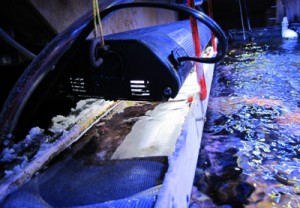In my opinion, marine aquarium hobbyists have a fundamental misunderstanding of algae. It is not a disease, and it can’t be cured, as it grows on every healthy reef in the sea. We don’t usually see as much of it in the sea because of all the herbivores there and the fact that most of the ocean is much too deep for algae to grow.
But we do know algae grows on the reefs. If it didn’t, we wouldn’t have so many tangs, rabbitfish, urchins, slugs, snails, etc. In fact, if you dive at night, you will see that the reefs are covered in urchins—and they are not eating Burger King! All these creatures keep the algae cropped too short to notice, but if you remove them from the reef, the algae would soon engulf the corals.
Potty-training herbivores?
Of course, we don’t want algae to cover the corals and aquascape we have in our home aquariums. However, algae-eating animals don’t help as much in an aquarium because they just poop the algae nutrients right back into the water a short while after they eat it—unless, of course, you can teach them to poop outside the tank. This is a challenge, though, because the urchins and snails keep falling off the glass trying to climb back in. I won’t even discuss the difficulty of finding a suitably sized toilet!
Beneficial and self-limiting
Algae is a healthy component of any reef system. It removes unwanted chemicals, releases oxygen, and may impart some healthy substances into the water. It’s also self-limiting, growing only to the point where it exhausts even one component it needs to grow. It could be nitrogen, phosphorous, or even iron.
In marine aquariums, algae tends to come and go in cycles. Sometimes my tank would get hair algae for a few months, then it would go away and not return for three or four years. If you keep a marine tank long enough, you will see these cycles. I don’t mind. I want algae to grow, as it is a normal part of all healthy reefs in the sea. The key is to get it to grow where you direct it to grow and not in your main display.
Fight algae with algae!
So how do you coax algae to grow only where you want it and not smother your corals? This is simple to do, as most algae are fairly stupid. All you need to do is create a place for algae to grow that provides better growing conditions than on your corals. The algae encouraged to grow in this location will then help remove the dissolved nutrients that promote algae growth in the main aquarium. In essence, algae is the best algae remover—with the added benefit that it’s natural and free.

An algae sanctuary
Algae love light, nutrients, and water movement. These things are all present in our aquariums, but we can harness and enhance them, forcing the algae to grow where we want it.
Lighted refugia are usually used for this purpose, and you could buy or build one. A lighted refugium is just a compartment located in, on, or under an aquarium that is brightly lit and designed so the tank water flows through faster than it flows in the main tank. The algae just loves to grow in these ideal conditions and would “rather” grow there.
I don’t have a sump, so I built a trough, or tray, that sits above and to the rear of my tank. It’s constructed out of a Home Depot 4-inch by 4-inch PVC fence post that I sliced in half. It’s fed from the outflow of my protein skimmer and positioned at a slight angle so water flows back to the surface of the tank.
The water in the trough is very shallow, about ½ inch deep, and there is a bright light positioned a few inches from it. I also installed a screen on the bottom of the trough that I can roll up and remove if it needs cleaning. The shallow, brilliantly lit trough with water swiftly flowing through it is like candy to algae, and if it grows anywhere in my system, it will grow there.
My reef tank used to get large cycles of hair algae, but there hasn’t been any growing in there for quite a few years. Now, all that algae grows in the trough and I can just roll up the screen to remove it!
Photo credit: Paul Baldassano



